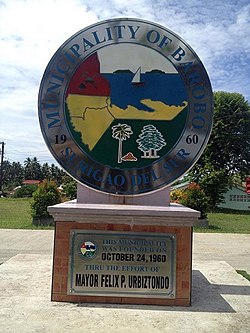History
Legend has it that the Manobo tribesmen first inhabited the area in the central part of Surigao del Sur. Sometime in the 1930s, five families who were engaged in fishing landed in the up-end of the river, and settled in the area for easy access to the fishing grounds. The area became known for its bountiful fish catch, and therefore more people from neighboring areas also came and settled. The distinctive visual quality of the area was an endemic species of tree known as "barobo" (diplodiscus paniculatus), which was plentiful on the site of the settlement. Subsequently, the place became popularly known as Barobo.
Barobo subsequently became a barrio under the municipality of Lianga. The creation of the province of Surigao del Sur under R.A. No. 2786, series of June 1960, created the municipality of Barobo on October 24, 1960, by virtue of Executive Order No. 407 issued by President Carlos P. Garcia. Thus the Municipality of Barobo was carved out (in a shape resembling that of a cigar pipe) from its mother municipality, Lianga.
Geography
Barobo lies in the central part of the province of Surigao del Sur. It is located between 8'34'00" and 8'25'00" latitude and 125'59"00 and 126'22'4" longitude. It is bounded on the north by Lianga Bay and the municipality of Lianga, on the south by the municipality of Tagbina, on the southeast by the municipality of Hinatuan, on the east by the Pacific Ocean, and on the west by the municipality of San Francisco, Agusan del Sur.
It has total land area of 24,250 hectares (59,900 acres). It is linked by a national road to the provincial capital of Tandag, Surigao del Sur, of 103 kilometers (64 mi) and the gateway to the regional center of the Caraga Region in Butuan of 107 kilometers (66 mi).
Tourism
15,000 hectares (37,000 acres) of its total land is used for the tourism industry with declared tourist destinations namely, Turtle Island, Cabgan Island, Vanishing Islet, Pongpong Resort, Pagbutuanan Cave, Bogac Cold Spring, Beto Lagoon, Panaraga Beach Resorts and Dapdap Beach Resorts. The Barobo River was named as the cleanest urban river in the country by numerous blogging award-giving bodies.
Barangays
Barobo is politically subdivided into 22 barangays. Each barangay consists of puroks while some have sitios.
- Amaga
- Bahi
- Cabacungan
- Cambagang
- Causwagan
- Dapdap
- Dughan
- Gamut
- Guinhalinan
- Javier
- Kinayan
- Mamis
- Poblacion
- Guinhalinan
- Rizal
- San Jose
- San Roque
- San Vicente (Poblacion)
- Sua
- Sudlon
- Tambis
- Unidad
- Wakat
Climate
| Climate data for Barobo |
|---|
| Month | Jan | Feb | Mar | Apr | May | Jun | Jul | Aug | Sep | Oct | Nov | Dec | Year |
|---|
| Mean daily maximum °C (°F) | 29.0
(84.2) | 29.1
(84.4) | 30.1
(86.2) | 31.1
(88.0) | 31.7
(89.1) | 31.6
(88.9) | 31.7
(89.1) | 31.9
(89.4) | 31.9
(89.4) | 31.5
(88.7) | 30.7
(87.3) | 29.7
(85.5) | 30.8
(87.5) |
|---|
| Daily mean °C (°F) | 25.3
(77.5) | 25.4
(77.7) | 26.1
(79.0) | 26.8
(80.2) | 27.4
(81.3) | 27.2
(81.0) | 27.2
(81.0) | 27.3
(81.1) | 27.3
(81.1) | 27.1
(80.8) | 26.5
(79.7) | 25.9
(78.6) | 26.6
(79.9) |
|---|
| Mean daily minimum °C (°F) | 21.7
(71.1) | 21.8
(71.2) | 22.1
(71.8) | 22.6
(72.7) | 23.2
(73.8) | 22.9
(73.2) | 22.7
(72.9) | 22.8
(73.0) | 22.7
(72.9) | 22.7
(72.9) | 22.4
(72.3) | 22.2
(72.0) | 22.5
(72.5) |
|---|
| Average rainfall mm (inches) | 639
(25.2) | 482
(19.0) | 402
(15.8) | 297
(11.7) | 264
(10.4) | 227
(8.9) | 207
(8.1) | 198
(7.8) | 211
(8.3) | 221
(8.7) | 325
(12.8) | 535
(21.1) | 4,008
(157.8) |
|---|
| Source: Climate-Data.org [6] |
Barobo has a tropical rainforest climate (Af) with heavy to very heavy rainfall year-round.
This page is based on this
Wikipedia article Text is available under the
CC BY-SA 4.0 license; additional terms may apply.
Images, videos and audio are available under their respective licenses.




